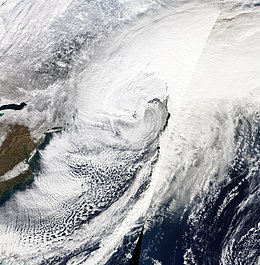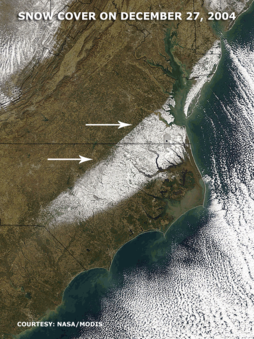Not to be confused with December 21–24, 2004 North American winter storm.
| This article needs additional citations for verification. Please help improve this article by adding citations to reliable sources. Unsourced material may be challenged and removed. Find sources: "2004 Christmas Eve United States winter storm" – news · newspapers · books · scholar · JSTOR (February 2024) (Learn how and when to remove this message) |
 The nor'easter at peak intensity offshore of Atlantic Canada, on the morning of December 27 The nor'easter at peak intensity offshore of Atlantic Canada, on the morning of December 27 | |
| Type | Winter storm Nor'easter Tornado outbreak |
|---|---|
| Formed | December 24, 2004 |
| Dissipated | December 28, 2004 |
| Lowest pressure | 964 mbar (hPa) |
| Maximum snowfall or ice accretion | 18 inches (45.7 cm) |
| Areas affected | South Central United States, East Coast of the United States |
| Part of the 2004–05 North American winter | |
The 2004 Christmas Eve United States winter storm was a rare weather event that took place in Louisiana and Texas in the United States on December 24, 2004, before the storm moved northeast to affect the coastal sections of the Mid-Atlantic states and New England in the succeeding few days. This was a different storm from the historic event that struck the Midwest and southern Canada around December 23 from another cyclone which preceded this storm. The event involved a thin band of snowfall with unusually cold temperatures for the middle Texas coast, and caused dozens of varied weather records to be shattered. It was the most significant snow for the Texas Gulf Coast, and deep South Texas, since February 1895.
Anticipation of the event
There had been indications for up to a week before the event that a frontal wave in the Gulf of Mexico was expected to track far enough to the south (along roughly the 26th parallel) to lead to snow along the Gulf of Mexico coastline of the United States.
Synoptic history
A surface cyclone formed in the western Gulf of Mexico on December 24 due to a shortwave aloft, and moved eastward through the western Gulf of Mexico, bringing banded snowfall to the middle Texas coast. The extratropical cyclone moved east, then northeast, tracking across the northern peninsula of Florida early on December 26 before moving about 100 miles (200 km) offshore the Southeast, paralleling the coast. Continuing to deepen, the developing storm moved about 200 miles (300 km) offshore the Mid-Atlantic states, New England, and Atlantic Canada on December 27 before moving out to sea.
Effects

Texas and Louisiana
The most noticeable, and unusual, event associated with the storm was the snowfall it produced. Much of the snow fell in southern Texas, along the coast of the Gulf of Mexico, but some snow, albeit less deep, fell across southern Louisiana. Any snowfall in these areas is extremely unusual, perhaps occurring once every twenty years, and these events are usually airborne flurries which melt on contact with the ground. In many places the snow stuck to the ground and accumulated to an appreciable depth. In Brownsville, Texas, snow fell to a depth of 1.5 inches (3.8 cm), the first measurable snowfall at the city in over 100 years, since the Great Blizzard of 1899.

The fact that the snow accumulated overnight on Christmas Eve led to a White Christmas the next morning, something completely foreign to the region. Across all of southern Texas and in southwestern Louisiana, snow fell in places where it had not for anywhere from 15 to 120 years. Near the coast, in Corpus Christi, Texas, 5.2 inches (13 cm) of snow fell, more snow than in all previous recorded years combined. This was also the case in Victoria, Texas, where a significant 13.0 inches (33 cm) fell. New Orleans, Louisiana had its first white Christmas in 50 years. In addition to the unusual occurrence of snow inland, moderate to heavy snow was also reported over the open waters of the Gulf of Mexico. This is the first significant snow fall in Houston since February 12, 1960, when a snowstorm hit central and south Texas with eight to 10 inches of snow.

Some snow totals:
- Alice, Texas: 12 inches (30.48 cm)
- Beeville, Texas: 10.0 inches (25.4 cm)
- Brownsville, Texas: 1.5 inches (3.8 cm)
- Corpus Christi, Texas: 5.2 inches (13.2 cm)
- El Campo, Texas: 11.0 inches (27.9 cm)
- Galveston, Texas: 4.0 inches (10.16 cm)
- Houston, Texas: 1.0 inches (2.5 cm)
- Kingsville, Texas: 6.0 inches (15.24 cm)
- Lake Charles, Louisiana: 1.2 inches (3.1 cm)
- Laredo, Texas: 2.0 inches (5.07 cm)
- Mathis, Texas: 11 inches (27.9 cm)
- McAllen, Texas: 4.0 inches (10.16 cm)
- New Orleans, Louisiana: 0.7 inches or more (1.8 cm)
- Pearland, Texas: 2.8 inches (7.3 cm)
- Sandia, Texas: 12 inches (30.48 cm)
- Victoria, Texas: 13.0 inches (33.0 cm)
Georgia and South Carolina
As the cyclone tracked through Florida offshore the Southeast, up to an inch of freezing rain and sleet fell at Augusta and Aiken.
North Carolina
Several inches of snow fell across portions of the state, with the highest amount noted of 9.5 inches (24 cm) at Ahoskie.
Virginia

(Click on the image and zoom in for place labels)
Several locations across the Tidewater reported over a foot of snow, with the highest amount of 14 inches (36 cm) reported at Quinby and Tabb. Frontogenesis (strengthening temperature gradient) within the comma head of the extratropical cyclone between the 500 hPa and 700 hPa layers (or 10-20 kft) contributed to the banded snow seen across this region. It led to the snowiest December across the Norfolk area since 1958.
Maryland
Light to moderate snow fell on the Eastern Shore, with the highest amount of 4.5 inches (11 cm) measured at Shelltown.
New Jersey
On December 25, 2004, there was light to moderate snowfall across portions of the state, with the highest amount of 2 inches (5.1 cm) falling at Mount Holly.
New York
Southeastern sections of the state saw the snowfall. The highest amount reported was 8.7 inches (22 cm) at East Hampton.
Connecticut

Moderate to heavy snow fell across much of the state. The highest total reported was 7 inches (18 cm) at East Killingly.
Rhode Island
Heavy snow fell statewide. The highest total was 8.2 inches (21 cm) at Tiverton.
Massachusetts
The heaviest snowfall from the storm fell across Massachusetts. Brewster measured 18 inches (46 cm) during the event.
New Hampshire
Central and southern sections of the state saw moderate to heavy snow. The highest amount was 9 inches (23 cm) at Salem.
Vermont
Snow fell across portions of the state during this storm, with 6 inches (15 cm) falling at a dairy farm in Franklin.
Maine
Heavy snow fell across portions of Maine. The highest amount reported was from Whiting where 13 inches (33 cm) was measured.
See also
- Cyclogenesis
- Extratropical cyclone
- Pre-Christmas 2004 snowstorm that impacted the Midwest
- Snowstorm
- Surface weather analysis
References
- National Weather Service Forecast Office, Houston/Galveston, Texas."Public Information Statement". Archived from the original on December 12, 2006. Retrieved 2006-12-01. Retrieved on Dec. 1, 2006.
- Glenn E. Lader. STORM SUMMARY NUMBER 5 FOR MAJOR WINTER STORM. Retrieved on Dec. 1, 2006.
- Glenn E. Lader. STORM SUMMARY NUMBER 5 FOR MAJOR WINTER STORM. Retrieved on Dec. 2, 2006.
- Pamela J. Szatanek. STORM SUMMARY NUMBER 7 FOR MAJOR WINTER STORM. Retrieved on Dec. 2, 2006.
- Timothy Gingrich and John Billet. Operational Considerations of the December 26, 2004 Snowstorm Across Hampton Roads, Virginia and Northeast North Carolina. Retrieved on Dec. 2, 2006.
- The Atlantic Coast Observer Network: Virginia, North Carolina, South Carolina. SUMMARY OF CLIMATOLOGICAL DATA: DECEMBER 2004. Archived September 23, 2006, at the Wayback Machine Retrieved on Dec. 2, 2006.
- ^ Bruce Terry. STORM SUMMARY NUMBER 9 FOR MAJOR WINTER STORM. Retrieved on Dec. 2, 2006.
- Jonathan Gates. The Bovine Bugle. Archived November 9, 2006, at the Wayback Machine Retrieved on Dec. 2, 2006.
External links
- Information about the storm from the Houston / Galveston National Weather Service Office.
- Images from Houston, Upper Gulf Coast, and Corpus Christi
- Images from Bay City and Baytown, Texas
- Images from Galveston, Texas
- Images from New York
| Major snow and ice events in the United States | |||||||
|---|---|---|---|---|---|---|---|
| 18th–19th century | |||||||
| 20th century |
| ||||||
| 21st century |
| ||||||
| Related | |||||||
- 2004 natural disasters in the United States
- History of Corpus Christi, Texas
- Natural disasters in Texas
- Natural disasters in North Carolina
- Natural disasters in Virginia
- Natural disasters in New York (state)
- Natural disasters in Connecticut
- Natural disasters in Rhode Island
- Natural disasters in Massachusetts
- Natural disasters in Vermont
- Natural disasters in Maine
- Nor'easters
- December 2004 events in the United States